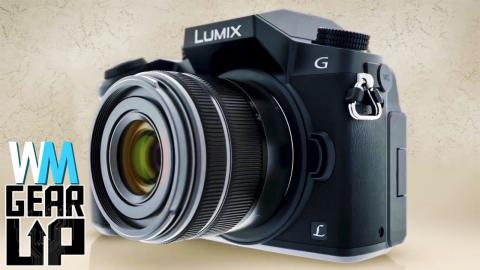Top 5 Best Starter DSLR Cameras - GearUP^

Hey everyone, I'm Marc Saltzman – tech reviewer – and you're watching Gear Up, the Watchmojo channel devoted to gadgets, gear and games.
In THIS video, we'll look at 5 recommended starter dSLRs and compact system “micro four-thirds” cameras.
Hey everyone, I’m Marc Saltzman – tech reviewer – and you’re watching Gear Up, the Watchmojo channel devoted to gadgets, gear and games.
In THIS video, we’ll look at 5 recommended starter dSLRs and compact system “micro four-thirds” cameras.
Not listed in any particular order…
1. The Nikon D3400
At under $500 for the body only, the Nikon D3400 offers a lot of bang for the buck. With the same design as last year’s model – hey, if it ain’t broke, why fix it -- the sturdy D3400 feels good in your hands, if a little lighter than the Nikon 3300, plus its features a 24.2-megapixel APS-C CMOS sensor, a boost in battery performance, and the addition of SnapBridge, which is Nikon’s Bluetooth-based solution for wirelessly transferring photos from your camera to your smartphone. Other features include HD 1080p video recording at 60 frames per second; Nikon’s “Guide Mode,” a helpful guide on the 3-inch screen for beginners to understand photography features like ISO and f-stop: and of course, there’s support for multiple Nikon lenses. Some downsides? No microphone port, no touchscreen, and limited autofocus features. Another great Nikon dSLR for beginners is the Nikon D5300.
OK, number 2…
2. The Canon Rebel T6i
While the T7i is newer and a great pick for beginners, the slightly older T6i for $749, body only, is more than enough as your first dSLR. Between its APS-C CMOS sensor with 24.2-megapixel resolution, and ISO from 100 to 12800 – and expandable even more – will help produce beautiful images. The 19-point autofocus system, and high-speed continues shooting will help make novice users feel like a pro shutterbug. Other features with noting: Full HD 1080p video shooting, a 3-inch articulating touchscreen, and built-in NFC and Wi-Fi to easy pair and share your images. It’s $150 more than the Nikon D3400 but worth the extra cash, especially if you have Canon lenses, such as a telephoto, macro or wide-angle option. The low-light performance isn’t the best, though, and battery life is a little behind others, but overall, a solid pick.
The third dSLR ideal for beginners and ones that won’t break the bank?
3. The Pentax K-70
At $600 for the body only, the Pentax K-70 is also a 24.2-megapixel camera with APS-C CMOS sensor, multiple ISO settings and an 11-point autofocus system -- but this entry-level dSLR boasts a dustproof and weather-resistant body. The vari-angle LCD monitor, with night vision red light LCD display, helps you see and analyze what you’re shooting – or use the viewfinder, of course, while integrated in-body shake reduction and motion correction will help minimize blur in your photos. Like the Nikon model, Pentax’s K-70 can also shoot Full HD video at 60 frames per second. On the connectivity front, there’s built-in Wi-Fi for use with the Image Sync app. The burst shooting mode doesn’t live up to the other cameras we’ve discussed but decent enough.
Now let’s talk about two mirrorless or “compact system” cameras.
4. Sony’s Alpha a5000
Capture memories with a premium camera – but without the premium price. At under $500, the super small Sony Alpha A5000 mirrorless camera with 16-50mm zoom lens included, delivers dSLR quality in a compact form factor, plus this 20.1-megapixel camera features integrated Wi-Fi connectivity to instantly share your images with the world, via a nearby smartphone. With high picture quality and sharp HD videos – thanks, in part, to the Alpha A5000’s large APS-C image sensor, along with fast-focusing, smart image stabilization, a 180-degree 3-inch tiltable LCD, and support for multiple lenses. While it’s awesome you get a lens in this kit and it’s still under $500, some downsides of the alpha a5000 include relatively slow burst speeds, non-touch LCD, and no 60p video recording.
And the no. 5 best beginning dSLR or mirrorless camera is the…
5. Panasonic Lumix G7
Slightly larger and heavier than the Sony Alpha a5000 mirrorless camera, the Panasonic Lumix G7 offers a responsive touchscreen, 4K video recording, burst mode that supports 30 photos per second, and more options when it comes to lenses. This easy-to-use 16-megapixel camera also features fast and precise subject-tracking and auto-focusing, and the ability to capture high-quality images in low light conditions with up to an amazing ISO 25,600. And as with most of the models in this round-up, the Panasonic Lumix G7 supports Wi-Fi sharing so you can upload to social media or the cloud.
So, what do you think of our picks for top starter SLR cameras or mirrorless cameras. Let us know in the comments section – especially if you own one of these models.
Thanks for watching Gear Up; I'm Marc Saltzman. For more tech-tastic lists, be sure to subscribe to WatchMojo.com. Ciao for now.
